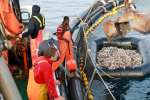As a big chill threatens refugees, UNHCR's 'Winter Cell' responds
News Stories, 22 January 2016
GENEVA, Jan 22 (UNHCR) – They call it the 'Winter Cell'. A small conference room in the bowels of the UN Refugee Agency, UNHCR, headquarters in Geneva. It has no windows, but computers and walls draped in screens and maps with handwritten and ever-changing numbers.
Formally known as the 'Winter Operations Cell', a small team of six are engaged in that hardest of tasks: forecasting.
Here trends are identified, problems flagged and hurdles foreseen as a potentially killer winter chill descends over Europe and the Middle East.
"We are set up to mitigate the effects of winter," said Winter Cell chief Chris Earney. "We are looking at situations caused by winter events, and we are looking at situations that are already there that would be compounded by the effects of winter."
The unit works in close cooperation with experts from the World Meteorological Organisation (WMO), the Met Office in the UK and the Met Service of South Eastern Europe to evaluate the impact of weather across a wide portfolio of both immediate response operations and longer planning and mitigation actions.
There are a lot of variables at play, not least since the unit covers a swathe of territory that stretches from the Polar Circle to the Aegean Sea. This presents strategic decision makers and those directly providing humanitarian assistance with some very unique strategic, operational and tactical challenges.
Just as the weather affects everything we do in our personal lives then by default the weather must also play a part in every aspect of Humanitarian Operations. The challenge set to the Winter Operations Cell is to harness a vast array of meteorological information to determine what benefits that can be realised across the full sphere of UNHCR operations in south-eastern Europe.
"This is a significant challenge, but one which is can now be met through the many meteorological agencies that, with the support of the WMO, are now moving towards what is called Impact Based Forecasting. This sees a move away from the traditional 'here's the weather today' approach, towards a much more user based service which looks at the impacts of the weather across the operations of a particular user to produce a much more tailored and therefore more beneficial service," the Met office explained in a statement.
In late January that approach is likely to face some tough tests. Below-normal temperatures plunging to lows of -5 to -15 C, accompanied by heavy snowfall, are forecast for the southern and eastern Balkan Peninsula, Turkey, the Eastern Mediterranean and the Middle East.
Across this vast area millions of refugees – most from Syria and Iraq – live in camps and settlements. Thousands of other people are on the move, many on foot or in flimsy, open boats.
"The Met Office has been an incredible partner to work with, both in terms of quality of staff and output but also just the speed at which they could respond," added Earney.
The team also monitors social media and coordinates with a point person in the intelligence unit inside Sweden's Migration Agency to keep abreast of the latest refugee movements. Knowing where refugees are at any given point is crucial to preparedness. A sudden snowstorm at a congested border without sufficient material support could have disastrous results.
Untangling the interplay between all these variables is a potentially life-saving exercise as weather conditions worsen and UNHCR determines where to best deploy its resources.
"We're building out a range of scenarios and situations, and we run each one with the refugee at the centre," said Earney. Depending on the assessment of risk – calculated as implication against likelihood – the team aims to send out specific recommendations or intelligence either directly to country offices or generally in its daily situation reports, which can be found on UNHCR's data portal.
Much of the work is done in real time. Information streams in from the Met Office, UNHCR field officers and the Swedish migration intelligence, and the numbers on those maps on the windowless walls inside the winter cell change, reflecting the situation on the ground. Some of the maps are stylized, like the one showing refugee routes north hanging on the inside of the door, which Earney calls the team's equivalent of the London tube map.
The job of making all this data accessible to outsiders falls to James Leon-Dufour, the team's information management officer.
An architect by background, Leon-Dufour tries to take all this data and "deliver it in an intelligible manner". He helps design how the information is presented, creating online visualisation of the routes population concentrations and the situation at borders.
A veteran of camp design, he is one of two architects on a team composed of people with different specialties. Ruxandra Bujor has five years experience of managing camps in the field. She is the one who keeps track of the 70 sites across Europe where refugees are concentrated and the aid that is available and delivered there.
Winter tends to make movement across borders, as well as within countries, difficult and sometimes impossible, Bujor said. Being able to provide materially for obstacles to movement runs alongside advocacy efforts, helping to ensure that all countries are ready to look after those who end up stranded.
Like the rest, Bujor is excited at the work the team is doing. The unit has only been up and running since the end of last October, but already its work has had an impact.
"At times, it does seem overwhelming, and it was in the beginning. But we've narrowed down our analysis and identified some of the key factors contributing to changes," said Bujor.
UNHCR wishes to thank the WMO, Met Office in the UK, SE European Met Services for their help and support in supporting the operations of the UNHCR Winter Operations Cell
By Omar Karmi,Geneva










































